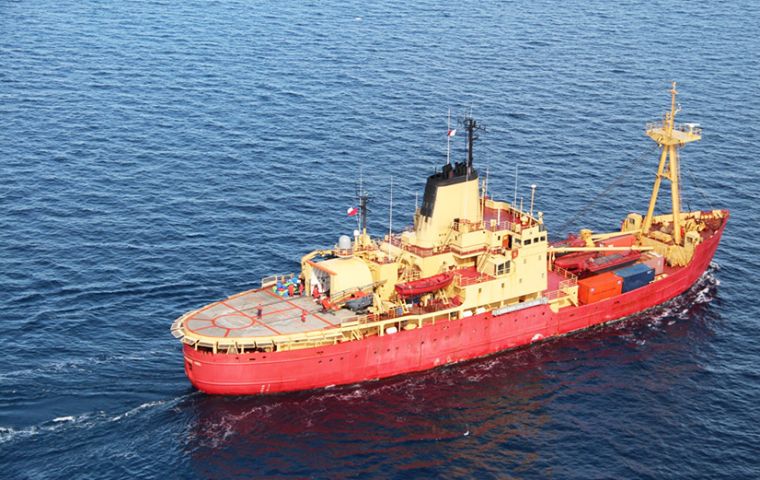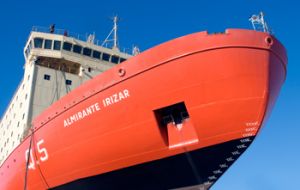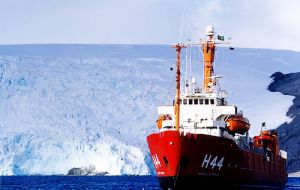MercoPress. South Atlantic News Agency
Chile plans to build a new icebreaker and has earmarked an initial 150 million
 Chile's current icebreaker “Almirante Oscar Viel” is coming to the end of its service life. Built in 1969 it belonged to the Canadian Navy
Chile's current icebreaker “Almirante Oscar Viel” is coming to the end of its service life. Built in 1969 it belonged to the Canadian Navy  Argentina's 11.000-ton Irizar was extensively damaged by onboard fire in 2007. Russia's Putin apparently offered support and financial credit
Argentina's 11.000-ton Irizar was extensively damaged by onboard fire in 2007. Russia's Putin apparently offered support and financial credit  Brazil has the 2,300-ton Ary Rongel, a Norwegian-built polar vessel, which was joined in 2009 by Almirante Maximiano, originally a US-built polar ship
Brazil has the 2,300-ton Ary Rongel, a Norwegian-built polar vessel, which was joined in 2009 by Almirante Maximiano, originally a US-built polar ship Chile is planning a strong expansion of its Antarctic and maritime support vessels as well as a major repair yard, according to a recent pledge by President Michelle Bachelet during the opening of the Exponaval and Trans-Port exhibitions in Valparaiso and Viña del Mar.
The shopping list includes a new icebreaker for Antarctic operations, a new ocean going patrol vessel and a floating shipyard capable of working with Post Panamax vessels.
Chile's current icebreaker “Almirante Oscar Viel” is coming to the end of its service life. Built in 1969 at Vickers Armstrong yards in Montreal, for the Canadian Navy it operated under the name of “Norman McLeod Rogers”, and was purchased by Chile in 1994. A year later she made her first Antarctica season, and has never missed one since.
“The objective is a vessel with all the necessary capacities to develop all kind of operations in the Antarctic area including a renewed scientific research potential”, said president Bachelet.
The Chilean leader also announced that she had ordered the construction of a new patrol vessel for the country's maritime to protect Chile's EEZ. Likewise the feasibility studies for the construction of a third floating shipyard have started with the purpose of helping with the upkeep of Post Panamax vessels in the South East Pacific.
Chilean defense sources said the icebreaker project to replace the 6.500 ton Almirante Viel include an initial budget of 150 million dollars and building the new 8.000 ton ice breaker with foreign technical assistance in local shipyard Asmar. Meanwhile, Marinero Fuentealba, an 1,800-ton offshore patrol vessel with reinforced hull for polar operations, is being completed by ASMAR for commissioning in August.
The Chilean announcement confirms South America's growing interest in Antarctica during the last two decades. In effect Colombia has plans to upgrade Antarctic assets and establishments, and thus join countries such as Brazil, Uruguay, Peru and Ecuador relatively new in the frozen continent, compared to the long established presence of Argentina and Chile.
Colombia, which launched its first Antarctic expedition in 2013, has plans for a permanent base and the procurement of a polar ship. Argentina, Chile and Peru, meanwhile, are all interested in procuring icebreakers.
“It is driven by the current push to exploit natural resources towards the North Pole, which South American countries expect to be replicated in Antarctica,” said Emilio Meneses, an analyst based in Santiago. Expectations are that it will change the Antarctic Treaty, which at the moment allows only scientific activities and forbids exploitation.
The countries with the most consolidated and longest presence in Antarctica are Argentina and Chile, and both nations have claims to substantial portions of territory in the so-called South American Quadrant. Both claims are slightly superposed on each other, encompassing the Antarctic peninsula under the names Land of San Martin and Land of O’Higgins, respectively. Adding complexity, the UK also has claims over the peninsula, which is called Land of Ross on British maps.
Argentina has six permanent bases in Antarctica, staffed by 250 military and civilian personnel including scientists, plus a number of posts and shelters that are used only during the summer.
Marambio is the biggest base, with DHC-6 Twin Otter transport and liaison aircraft and Mil Mi-17 medium transport helicopters permanently stationed there, while C-130 aircraft make frequent flights from Rio Gallegos in the continent. Argentina is also the only country in South America that owns a real icebreaker, the 11,000-ton Irizar completed in 1978 by Finland’s Wärtsillä. The ship was extensively damaged by onboard fire in 2007, and since 2009 has been through extended repairs and modification works, that are expected to be completed in 2015.
Its reactivation is under consideration now, after a Russian offer of technical support and financial credit received during President Vladimir Putin’s recent visit to Buenos Aires. Also under consideration is the purchase of the 10,500-ton icebreaker Kapitan Nikolaev, completed by Wärtsillä in 1978 and also being offered by Russia.
Chile has four permanent bases in Antarctica staffed by 160 people, including three belonging to the military services and a scientific base handled by the Foreign Affairs Ministry and its National Antarctic Institute, as well as a number of posts occupied only during summer. The biggest base is the Complex Presidente Frei, under Air Force control, with DHC-6 Twin Otter liaison aircraft and Bell 412 helicopters stationed permanently and C-130 flights connecting regularly from Punta Arenas.
The Brazilian Antarctic program started early in 1982 with the procurement of a 2,200-ton Danish-built polar ship, rechristened Barão de Teffé, which allowed its Navy to launch the first expedition the same year. Antarctic operations were handed in 1994 over to the 2,300-ton Ary Rongel, a Norwegian-built polar vessel completed in 1981, which was joined in 2009 by Almirante Maximiano, a US-built polar ship completed in 1974 and refitted in Bremerhaven during 2008. Brazil has not revealed intentions to buy an icebreaker, but it is a logical step likely to happen.
Brazil’s Antarctic base, Comandante Ferraz, established in 1984 and destroyed in 2012 by an explosion and fire, will be rebuilt with bigger facilities through an investment of 52 million.
Early in the 1980s, Peru initiated expeditions to Antarctica, and in 1983 established its first and sole base there, Macchu Picchu, staffed by 30 people. The Peruvian Navy operates the polar research ship Humbolt, completed in 1980 by local shipyard SIMA and to be replaced by the end of this decade by a locally built icebreaker. The costs are expected to amount to 80 million dollars and conversations are underway with foreign shipbuilders for technical support.
Uruguay has the bases Artigas and Elichiribehety, established in 1984 in 1991. Artigas is the biggest base, with a staff of 20 people and a Bell 212 helicopter permanently attached. Supplies are delivered by C-130 transport aircraft and the Uruguayan Navy’s 1,700-ton logistic ship Vanguardia, completed in 1976 in Poland for Easter Germany and acquired in the 1990s. Elichiribehety, is a summer station ceased by the British to Uruguay.
Opened in 1990, Ecuador’s single base Maldonado is logistically supported by Chile and used only on summer. Permanent use from 2016 have been announced, and the procurement of a polar ship is under study.




Top Comments
Disclaimer & comment rules-

-

-

Read all commentsArgentina has 6 bases in Antartica with 259 military personnel, if that is not militarising the South Atlantic I don't know what is. In fact all the southern cone countries have a presence there. Shame on you lot, hypocrites.
Dec 09th, 2014 - 09:32 am 0The RGs are the only ones who are totally incapable of servicing their own bases.
Dec 09th, 2014 - 10:28 am 0'Argentina is also the only country in South America that owns a real icebreaker, the 11,000-ton Irizar completed in 1978 by Finland’s Wärtsillä. ' I wonder where the millions spent fixing her have gone.......
This article seems to have come out of the pages of the Encyclopedia Britanica... Lots of information, but not a reflection of the actual situation.
Dec 09th, 2014 - 11:09 am 0If you needed one name to easily summarize the corrupt government that runs Argentina, it would be the Irizar. Perhaps the most expensive dry docked icebreaker in the This article seems to have come out of the pages of the Encyclopedia Britanica... Lots of information, but not a reflection of the actual situation. The Irizar will probably be scrapped.
Commenting for this story is now closed.
If you have a Facebook account, become a fan and comment on our Facebook Page!